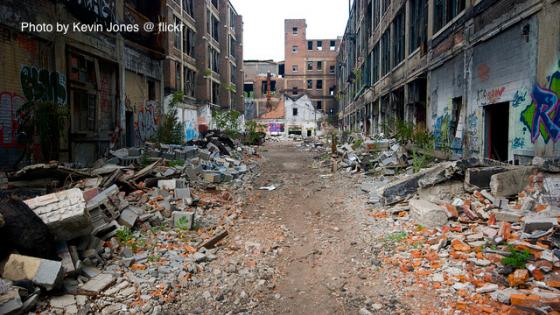The decline of manufacturing employment in industrialised countries has left behind an urban shadow: a number of cities with slowly declining populations and income per capita. There are many examples, but perhaps the most iconic is the city of Detroit, a city where Ford invented the automotive production line and which still hosts the headquarters of the main US car-manufacturing firms. Detroit’s population has declined by roughly two thirds since the 1950s, when it peaked at 1.8 million. This decline has likely created frustration and dissatisfaction among some of the residents that still live there; more so because it has left large sections of Detroit dilapidated and vacant, and led to severe financial problems for its government. The city filed for Chapter 9 bankruptcy in 2013 (see Sugrue 2015 for an interesting account of Detroit’s economic history).
During the last half-century, the decline of Detroit, and many other Rust Belt cities, coincided with the fast growth of other US cities. San Jose, for example, grew by a factor of ten between 1950 and 2010 (from less than 100,000 people to more than one million). Why was the considerable urban infrastructure of Detroit wasted while, at the same time, new cities were being built from the ground up? Why did the city decline in a way that distorted its urban form to make it less attractive and viable?
Distorted Detroit
Detroit’s current distorted form is evident. A successful downtown area, with hundreds of thousands of jobs, is surrounded by blight – neighbourhoods composed largely of vacant buildings, or vacant lots that are a holdover from recently demolished properties. These residential areas, built before 1930, used to be occupied by blue-collar and some white-collar workers. Now, they are mostly empty. Downtown workers live primarily in areas located farther away from the centre, in suburbs that are well connected to downtown Detroit via a number of radial highways. This urban structure is surprising because it violates some of the basic principles of urban economics and urban design, namely, the principle that states that residential areas locate close to business areas to minimise the commuting needs of residents. This is particularly so if these areas are empty and the jobs in the downtown business centre do not generate any negative externalities, such as pollution. In other words, why is it that we do not see residential developers convert these vacant areas into thriving residential neighbourhoods? Would these newly developed residential areas be able to substitute for some of the successful outlying suburbs in the Detroit metro area, but offer a shorter commute? The answer is important, since it can explain why the massive urban investments of the past are being wasted.
Developers and residents: A problem of coordination
In a new paper, we rationalise this urban outcome using neighbourhood residential externalities (Owens et al. 2017). Agents want to live close to other residents, since dense communities improve neighbourhood amenities. Local amenities generated by density can range from reductions in crime, to a greater variety of restaurants and other local services, to cheaper and better local government services. Independent of the particular form of these amenities, they are all facilitated by neighbourhood density. Of course, denser neighbourhoods are also more expensive and the additional availability of workers can have effects on local wages. Agents trade off all of these effects when they decide where to live. We argue that the scale required to successfully develop these neighbourhoods is too large for a single developer to undertake. As a result, developers do not internalise the residential externalities. Thus, development requires coordination between multiple developers, residents, and potentially the city governments that facilitate permits and public services.
This basic coordination problem between multiple residential developers and residents leads to two potential neighbourhood equilibria. Given the characteristics of the rest of the city, a neighbourhood can be developed or vacant. The vacant equilibrium is one in which no developer or resident has individual incentives to enter the neighbourhood, so no one does. In the coordination equilibrium, individual incentives lead enough developers to enter, making the neighbourhood viable for residents and profitable for developers. That said, the ease of coordination varies depending on the characteristics of the city. For example, the radial roads built throughout the mid-20th century increased the number of developers that were required to make today’s vacant areas viable, thereby making coordination more challenging.
Using a variety of data for Detroit’s metropolitan area, we quantify our spatial model and compute the parameters and local characteristics that rationalise the reality of Detroit today.1 We interpret the urban structure of Detroit as having 52 census tracts that are in the vacant equilibrium. Our interpretation is that they switched from the development to the vacant equilibrium sometime in the 1960s after the Detroit riots. We trace the main reasons behind the switch in part to ‘white flight’ and the loss of blue-collar manufacturing employment in the city proper, which started in the 1950s and accelerated afterwards, as well as the construction of the radial highways system. All of these factors increased the required scale to make these neighbourhoods viable and, therefore, the number of active developers and residents that needed to coordinate.
Our proposal: Development guarantees
One advantage of having a fully specified model that can rationalise Detroit’s misshapen urban form is that we can use it as a laboratory to evaluate visions for the city that have been proposed by stakeholders. Another advantage is that we can use it to design alternative policies that potentially benefit the city to an even greater degree. We propose ‘development guarantees’ as our policy instrument. This policy would require the city government, or some other party with credible access to funds, to guarantee a sufficient level of residential development in a neighbourhood. As a result, private developers and residents would have individual incentives to enter, and the neighbourhood would move to the equilibrium with coordination. Importantly, the development guarantees would have to be large enough, but if they were, they would ultimately require no actual investment by the guarantor. Our model allows us to compute the level of guarantees required to move any of the 52 vacant census tracts in the city to an equilibrium with coordination. It also allows us to compute the corresponding changes in population and land rents that result from this move.
We use this exercise to evaluate various policies proposed by Detroit Future City (DFC), a leading civic organisation. We then design an alternative policy that coordinates the same number of tracks as DFC, but ones that our model implies will be more successful in generating benefits. Overall, these policies can generate substantial positive returns. The DFC proposal yields more than $100 million per year in additional rents, while our policy generates almost twice that. The government guarantees required to achieve these outcomes total only about half of the measured gains in land rents. We find that a considerable fraction of the gains in business rents would be accrue to locations outside the administrative area of the city of Detroit. Therefore, sharing the tax revenue increases from these policies across municipalities, as well as the cost (or risk) of implementing them, seems important.
Even though the gains in rents that result from our proposed policy are impressive, they do not generate a large number of new residents in the city. The DFC policy attracts some 7,000 new residents while our policy adds about 12,000. These numbers are not negligible, but they certainly fall short of returning the city to its heyday. They improve Detroit’s urban form, but they do not bring back manufacturing employment. Still, they can help limit the waste that resulted from the structural transformation and shocks that declining urban areas across the world have experienced, and are likely to experience in the future. We can do better – much better – in managing urban decline.
References
Owens, R, E Rossi-Hansberg and P Sarte (2017), “Rethinking Detroit,” working paper, Princeton University.
Redding, S and E Rossi-Hansberg (2017), “Quantitative Spatial Economics,” Annual Review of Economics, forthcoming.
Sugrue, T (2015), “From Motor City to Motor Metropolis: How the Automobile Industry Reshaped Urban America”, Automobile in American Life and Society, Henry Ford Museum and University of Michigan.
Endnotes
[1] See Redding and Rossi-Hansberg (2017) for a review of the literature on spatial quantitative economics







